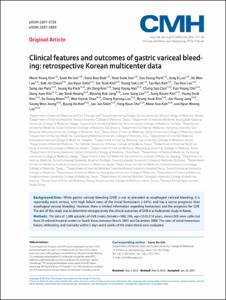KUMEL Repository
1. Journal Papers (연구논문)
1. School of Medicine (의과대학)
Dept. of Internal Medicine (내과학)
Clinical features and outcomes of gastric variceal bleeding: retrospective Korean multicenter data
- Keimyung Author(s)
- Hwang, Jae Seok; Jang, Byoung Kuk
- Department
- Dept. of Internal Medicine (내과학)
- Journal Title
- Clinical and Molecular Hepatology
- Issued Date
- 2013
- Volume
- 19
- Issue
- 1
- Abstract
- Background/Aims
While gastric variceal bleeding (GVB) is not as prevalent as esophageal variceal bleeding, it is reportedly more serious, with high failure rates of the initial hemostasis (>30%), and has a worse prognosis than esophageal variceal bleeding. However, there is limited information regarding hemostasis and the prognosis for GVB. The aim of this study was to determine retrospectively the clinical outcomes of GVB in a multicenter study in Korea.
Methods
The data of 1,308 episodes of GVB (males:females=1062:246, age=55.0±11.0 years, mean±SD) were collected from 24 referral hospital centers in South Korea between March 2003 and December 2008. The rates of initial hemostasis failure, rebleeding, and mortality within 5 days and 6 weeks of the index bleed were evaluated.
Results
The initial hemostasis failed in 6.1% of the patients, and this was associated with the Child-Pugh score [odds ratio (OR)=1.619; P<0.001] and the treatment modality: endoscopic variceal ligation, endoscopic variceal obturation, and balloon-occluded retrograde transvenous obliteration vs. endoscopic sclerotherapy, transjugular intrahepatic portosystemic shunt, and balloon tamponade (OR=0.221, P<0.001). Rebleeding developed in 11.5% of the patients, and was significantly associated with Child-Pugh score (OR=1.159, P<0.001) and treatment modality (OR=0.619, P=0.026). The GVB-associated mortality was 10.3%; mortality in these cases was associated with Child-Pugh score (OR=1.795, P<0.001) and the treatment modality for the initial hemostasis (OR=0.467, P=0.001).
Conclusions
The clinical outcome for GVB was better for the present cohort than in previous reports. Initial hemostasis failure, rebleeding, and mortality due to GVB were universally associated with the severity of liver cirrhosis.
Keywords: Gastric variceal bleeding, Rebleeding, Mortality, Cirrhosis
- Publisher
- School of Medicine
- Citation
- Moon Young Kim et al. (2013). Clinical features and outcomes of gastric variceal bleeding:
retrospective Korean multicenter data. Clinical and Molecular Hepatology, 19(1), 36–44. doi: 10.3350/cmh.2013.19.1.36
- Type
- Article
- ISSN
- 2287-2728
- Appears in Collections:
- 1. School of Medicine (의과대학) > Dept. of Internal Medicine (내과학)
- 파일 목록
-
-
Download
 oak-aaa-01401.pdf
기타 데이터 / 925.36 kB / Adobe PDF
oak-aaa-01401.pdf
기타 데이터 / 925.36 kB / Adobe PDF
-
Items in Repository are protected by copyright, with all rights reserved, unless otherwise indicated.